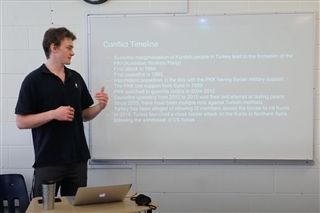For the past two months, IB Global Politics 12 students worked on their “Conflict” unit, which required them to gain an understanding of the various tools and theories behind conflict analysis. Students complimented their learning through discussions, videos and readings.
To demonstrate their knowledge, each student chose a conflict case study and tracked the conflict throughout the unit. Using the content and research that they gathered, students were able to tackle the unit project where they presented an in-depth analysis to bring awareness, educate others and showcase their understanding of the unit.
Students could present their conflict cases in a variety of ways, including visual storytelling, a Ted Talk-style oral presentation, Podcasts and more.
Alexandra Finn used a visual story to discuss the conflict between Iran and the United States, with an emphasis on the role of the JCPOA (Joint Comprehensive Plan of Action) power and state sovereignty looking at the past, present and future.
“I picked [this case] because I thought it was relevant to the world stage, and with Global Politics, that’s implied,” she explained. “A lot of conflicts we were given were based on nations and I thought this would be interesting to tie it to everywhere.
Having picked visual storytelling as her presentation method, she said she found photos that would help tell her story about how the conflict was breaking down through real-world pictures and media.
“I used a fair amount of the conflict tracker to show the different stories,” she said. “I talked a little bit through each president, and I talked a bit about Iran’s understanding of the US, the US understanding of Iran, and how it could be different and polarized.”
Patrick Michalak chose to focus on Ukraine for his conflict case, specifically the Ukrainian separatists and the influence of the Russian government. He wanted to put his focus on that topic because he’s from the region.
“It’s a little easier for me to talk about considering I have some background knowledge, and it’s always a topic when I go back home. Also, partially because I think it’s an incredibly interesting and terrifying concept that a country can annex another, with previously Ukraine-controlled Cremnia,” he said.
Patrick did an interview-style Ted-Talk, where he presented with slides, but had time for questions at the end. He talked about the causes and stages of conflict and covered the journey.
“This project was a lot more fun and informative than most,” he said. “It felt like it gave us room to really analyze the thing that is happening, and we are taking what we learned, instead of just quickly applying it and moving on. The way we presented it gave the assignment extra value.”
Gabrielle MacPherson chose the Iran and United States conflict, examining it from the 1970s to present day. To tell her story, Gabby chose to make a breaking newscast as she provided key details on events within the conflict and how some of them relate to conflict analysis theory.
“I was really interested to see how the relationships would change with President Biden because things were more heated with the Trump administration, and I’m really interested to see how the new president chooses to address it,” explained Gabby. “I know Biden is trying to strengthen the Iran nuclear deal, to bring them back to the table and create diplomatic relations again, which is exciting, so I’m excited to see if that is effective or not. The best strategy would be to understand the history behind it.”
Rowan Morahan used video commentary to discuss the ongoing Turkey-Kurdish conflict with an emphasis on the historical and ethnic causes of it, while providing an analysis of the ongoing peace efforts and their effectiveness in ending the conflict.
“I wanted to learn more about it and shed more light on the issue because it seems like something that has been swept under the rug even though ten of thousands of innocent people have been killed, and millions displaced,” he explained.
The speech that Rowan gave was an easy way for him to display his thoughts. As someone who is part of debate and public speaking, it was more intuitive for him to deliver his thoughts out loud.
The IB Global Politics students demonstrated a lot of creativity in how they chose to show and present their case studies. Some students even created podcasts to share their knowledge. Great work by all of the students!





